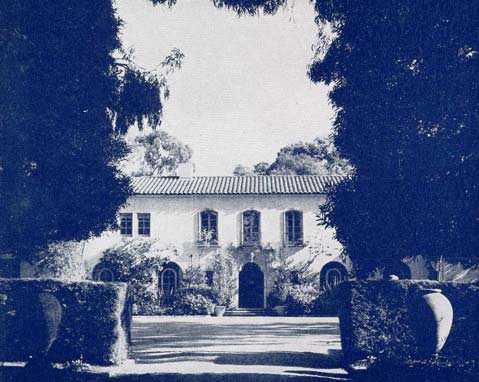What is the history of the estate that houses the Music Academy of the West?
In 1950, the Estate Known as Miraflores Became the College's Permanent Home

In 1908, the Santa Barbara Country Club, today called the Montecito Country Club, opened the doors of its new clubhouse off Channel Drive. This began a chain of events that ultimately led, in 1950, to the Music Academy of the West claiming the estate known as Miraflores as its permanent home.
In the early morning hours of June 28, 1912, fire broke out at the Santa Barbara Country Club. According to David Myrick in his history of Montecito, the club steward happened to be walking home along Cabrillo Boulevard when he spotted flames in the vicinity of the clubhouse. Breaking into a run, he found the building fully engulfed. He also discovered the assistant steward, shot twice by an intruder. The identity of the attacker was never uncovered, but authorities strongly suspected the shooter was also the arsonist, motive unknown.
Plans immediately were put forward to construct a new clubhouse with architect Francis Wilson engaged to draw up the design. Among Wilson’s local commissions were the Santa Barbara train depot, the Santa Barbara Club building on the 1000 block of Chapala Street, and the post office (now the Santa Barbara Museum of Art). The new clubhouse was finished in spring 1913.
Within a few years, as the club’s membership continued to grow, it became clear that the clubhouse and its adjacent nine-hole golf course were becoming increasingly inadequate and plans for yet another new clubhouse soon were in the works. This would become the Montecito Country Club facility with which we are familiar today.
What was to become of the old clubhouse? In 1917, John Percival Jefferson, the last president of the Santa Barbara Country Club before it re-incorporated under the Montecito name in 1921, bought the old clubhouse as a residence.
Jefferson was born in Delaware in 1852. Orphaned when just a baby, he was raised by an uncle. For a while, it appeared he was headed for a military career. He graduated from West Point in 1875 and entered the artillery branch of the service. He left the army, however, after eight years to go into business. In 1902, he became the president of a Pennsylvania firm that manufactured gas- and steam-powered engines, a position he would hold until his death 30 years later. He also got involved in banking and the lumber trade.
He and his second wife, Mary, hired architect Reginald Johnson to transform the clubhouse into a home. Johnson would later design the Biltmore Hotel and the main post office building on the 800 block of Anacapa Street. Work on the 18-acre estate basically was completed in 1919. The arches that graced the clubhouse were removed. The living room was paneled in wood to give it a warmer feel. Landscape architect Paul Thiene was commissioned to design the gardens, which would include ponds, sculptures, greenhouses, and reflecting pools. The proud owners named their new home Miraflores: “Look at the Flowers.”
The Jeffersons gave their house in Pennsylvania to the YWCA and settled into the social whirl of Montecito. Mary Jefferson outlived her husband by 18 years. Upon her death in 1950, Miraflores passed into the hands of Helen Marso, who had been a secretary to the Jeffersons for many years and was the executrix of Mary Jefferson’s will. The Jeffersons had no children. Marso then donated the estate to the Music Academy of the West, which had been holding its summer sessions in temporary quarters at Cate School near Carpinteria. She served on the Music Academy’s board of trustees until leaving Santa Barbara in 1957. Now, every summer on the South Coast is enriched by the programs of the Music Academy of the West, working out of its headquarters at Miraflores.



